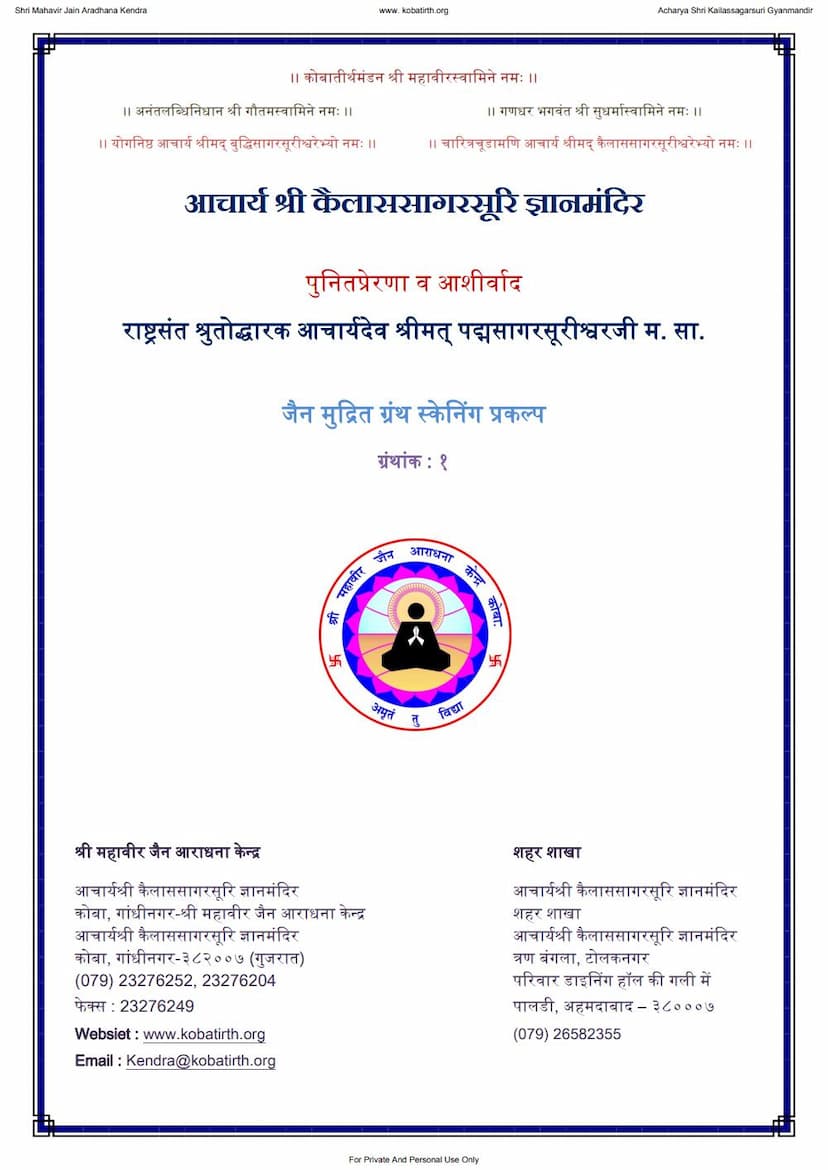Shatrunjay Uddhar Ras
Added to library: September 2, 2025

Summary
Here's a comprehensive summary of the Jain text "Shatrunjay Uddhar Ras" by Nayvijay, based on the provided pages:
The "Shatrunjay Uddhar Ras" is a devotional work that celebrates the significance of Shatrunjay, one of the most revered pilgrimage sites in Jainism. The text, written in Gujarati poetic form (Ras), details the history and importance of the mountain and the numerous renovations and constructions (Uddhars) undertaken there by various spiritual figures and rulers throughout different eras.
Key Themes and Content:
-
The Supremacy of Shatrunjay: The text begins by establishing Shatrunjay as a supreme holy site, unmatched by any other. It emphasizes its eternal nature and its connection to countless Tirthankaras who attained liberation there. The mountain is compared to celestial entities like Mount Meru in its grandeur and importance.
-
Historical Significance and Tirthankaras: The "Ras" highlights that the first Tirthankara, Bhagwan Rishabhdev (Adinath), established his presence and preached the Jain dharma at Shatrunjay. It mentions that Lord Rishabhdev, along with his 84 Ganadharas (chief disciples) and numerous munis, attained liberation from this sacred mountain. The text also references the presence of other Tirthankaras and their spiritual followers at Shatrunjay.
-
Merits of Visiting Shatrunjay: The text extols the virtues of visiting Shatrunjay, stating that even seeing the mountain removes misfortunes and fulfills desires, leading to eternal spiritual reign. It also mentions that performing seva (service) at this tirth can lead to liberation within three lifetimes, even for beings considered less fortunate.
-
The Cosmic Eras and the Mountain's Form: A significant portion of the "Ras" describes the mountain's scale and form across the different cosmic cycles (Utsarpini and Avsarpini). It details the height of the mountain and the number of enlightened beings (yojan, hasta) present during each of the six periods of these cycles, emphasizing its enduring spiritual presence.
-
The First "Uddhar" by Bharat Chakravarti: The narrative then focuses on the historical accounts of the first major renovation and establishment of temples at Shatrunjay by Bharat Chakravarti, the eldest son of Bhagwan Rishabhdev. It details the immense procession, the vast number of attendants, princes, ministers, merchants, and the construction of numerous temples and images of Tirthankaras and Ganadharas. This event is presented as a pivotal moment in solidifying Shatrunjay's sanctity.
-
Subsequent "Uddhars" by Various Rulers and Figures: The text meticulously chronicles subsequent "Uddhars" or renovations of the temples and the mountain itself. These are attributed to:
- Subsequent rulers from Bharat's lineage: The "Ras" mentions several successors from Bharat's lineage who continued the tradition of renovating Shatrunjay, maintaining the sanctity and structures established by their ancestor.
- Divine beings (Indras): Several Indras (celestial rulers) are mentioned as undertaking renovations at different points in time, indicating the continuous spiritual significance and the veneration Shatrunjay receives even from heavenly beings.
- Tirthankaras and their followers: The text notes that Tirthankaras like Bhagwan Ajitnath and Bhagwan Chandraprabhuji also visited Shatrunjay and contributed to its upkeep or renovation.
- Historical figures like Vikramaditya and Vastupal: The narrative highlights the contributions of influential historical figures, including King Vikramaditya and the renowned minister Vastupal. Vastupal is credited with significant repairs and restorations, including at Girnar, another important Jain pilgrimage site.
- Merchant-Kings and Royal Patrons: Numerous merchant-kings (Sanghpatis) and rulers are mentioned who undertook various renovations, investing immense wealth and devotion.
-
The Role of Devotion and Merit: Throughout the "Ras," the underlying theme is the immense spiritual merit (punya) gained by undertaking the pilgrimage and contributing to the maintenance and renovation of Shatrunjay. The text suggests that such actions lead to the purification of karma and attainment of liberation.
-
The Authorship and Patronage: The publication is presented by Shri Mahavir Jain Aradhana Kendra and published by Somchand D. Shah. The text is dedicated to spiritual gurus and lineage.
-
Concluding Prayers and Benedictions: The "Ras" concludes with devotional verses, expressing gratitude for the human birth and the opportunity to venerate Shatrunjay. It ends with prayers for spiritual progress and liberation, and a blessing from the learned pandits and gurus of the tradition.
In essence, "Shatrunjay Uddhar Ras" is a historical and devotional compilation that serves as a testament to the enduring reverence for Shatrunjay in Jainism. It highlights the continuous efforts throughout history to preserve and enhance this sacred site, underscoring the spiritual significance of devotion, pilgrimage, and selfless service in achieving liberation.